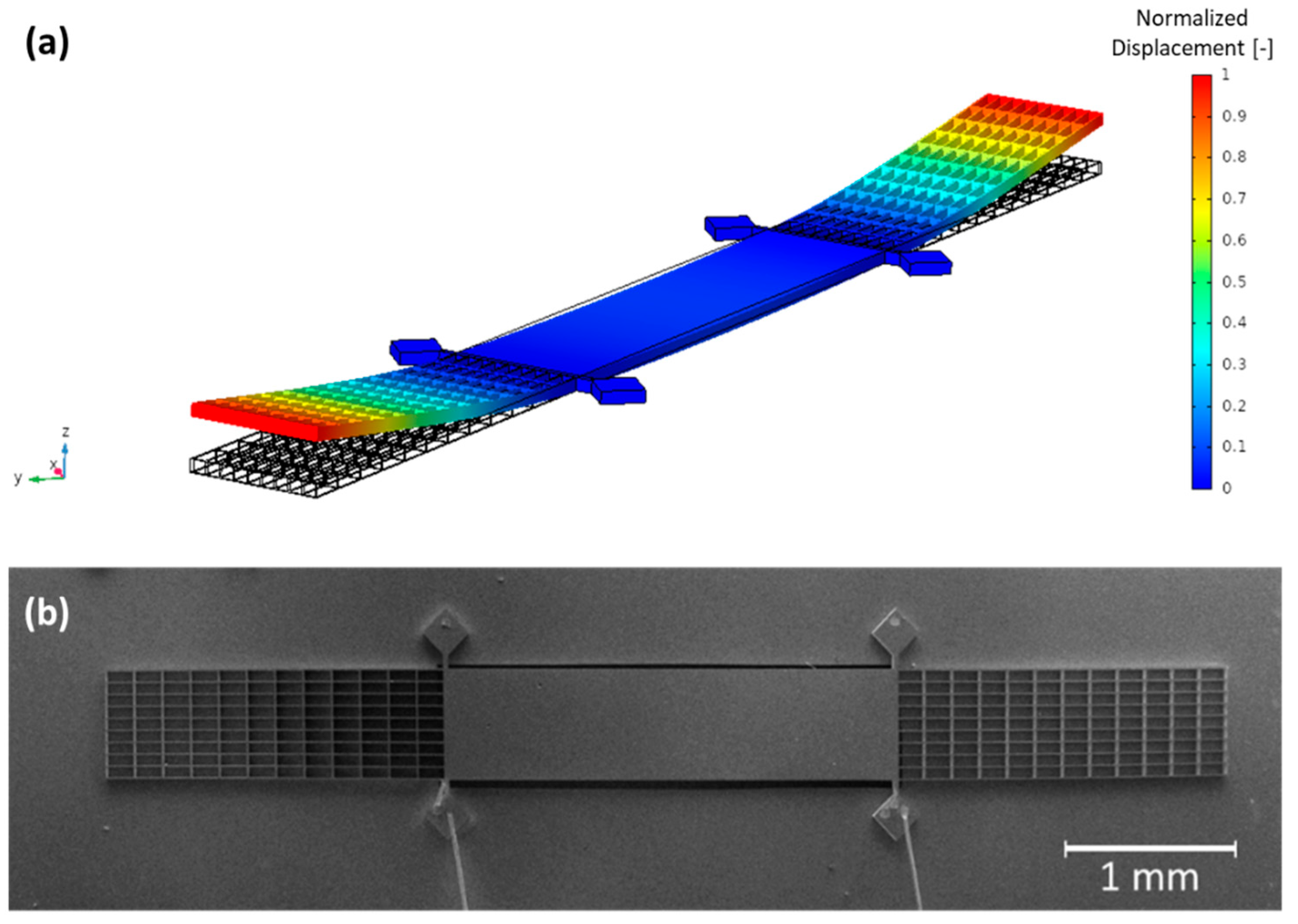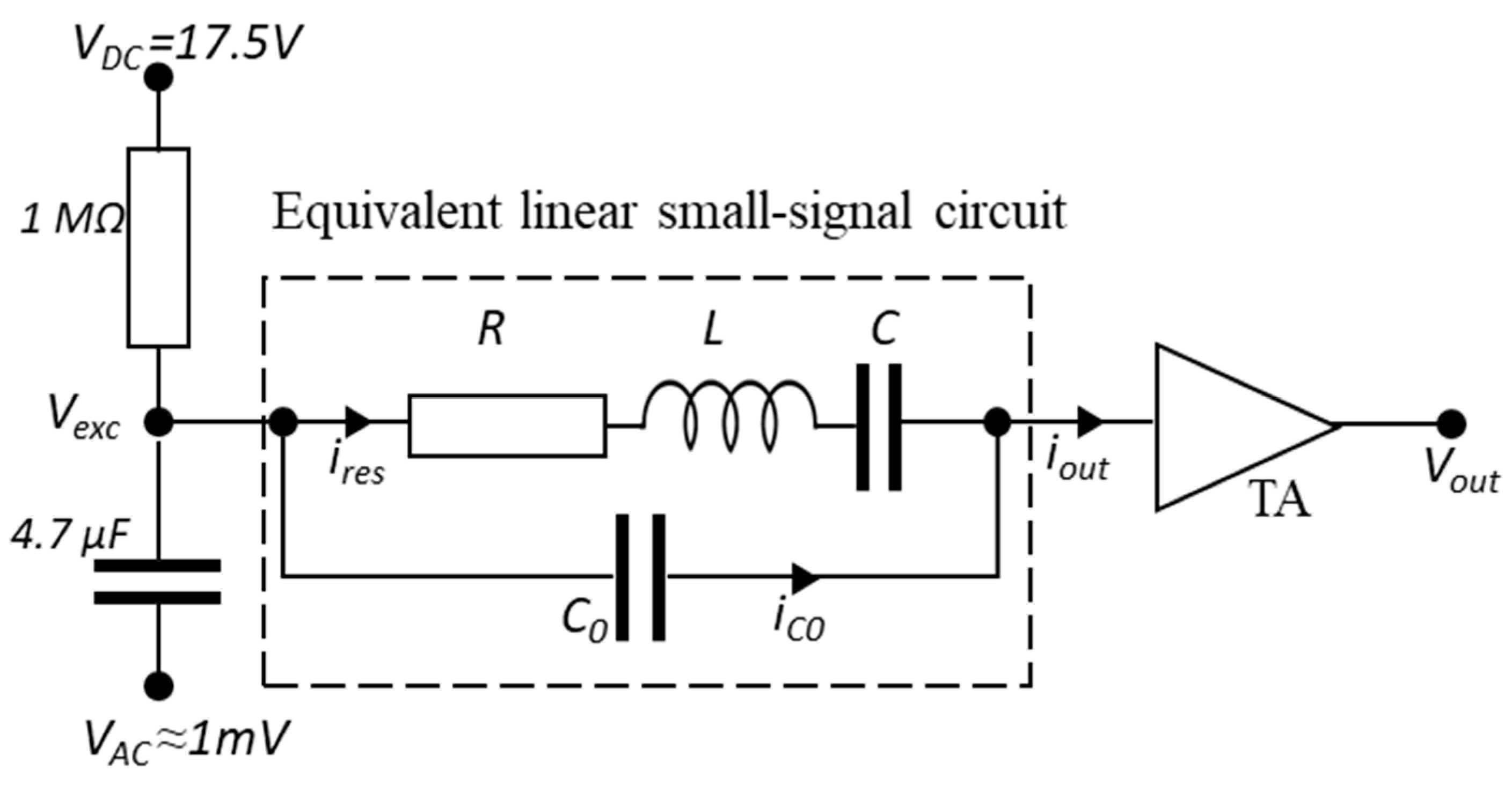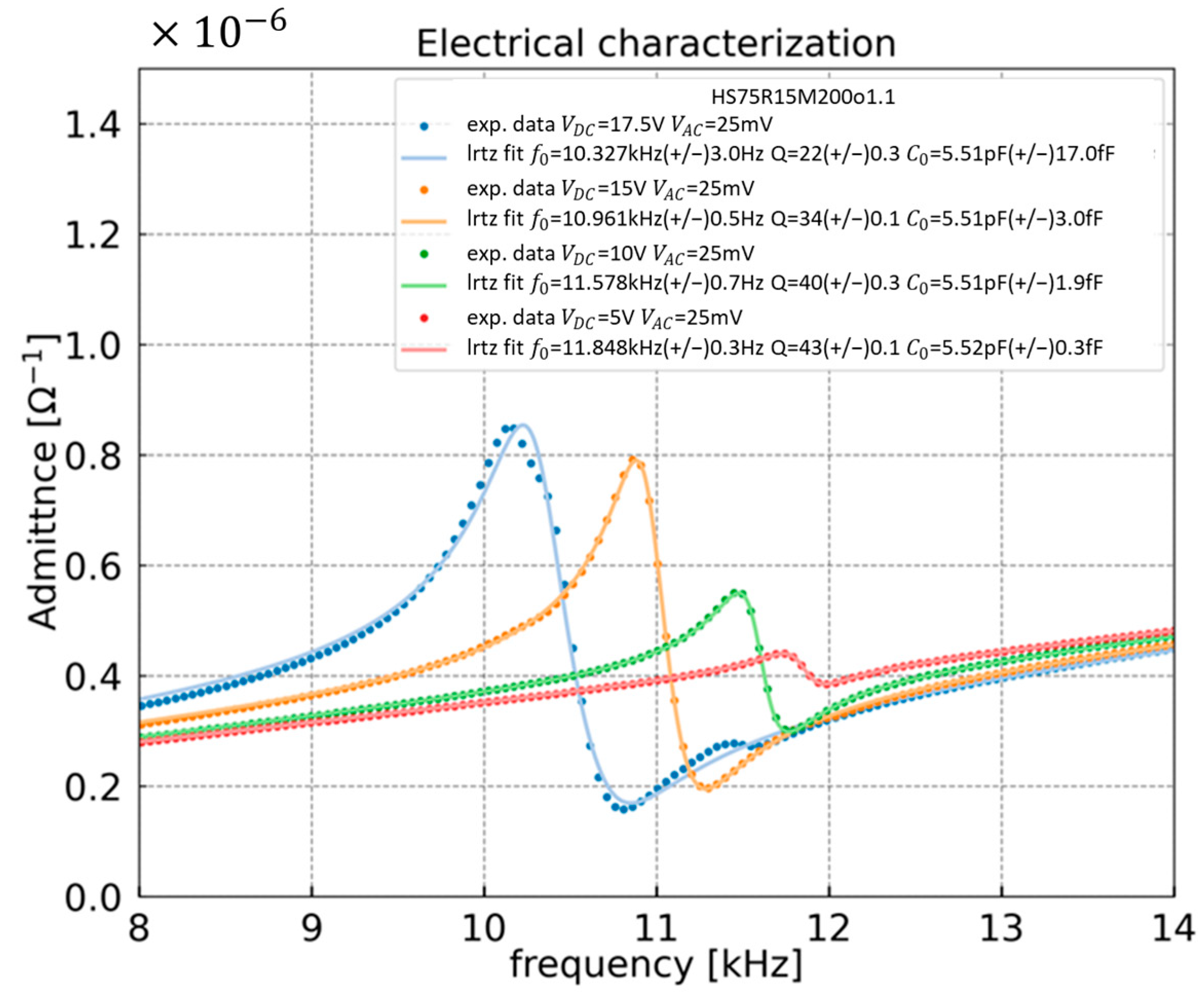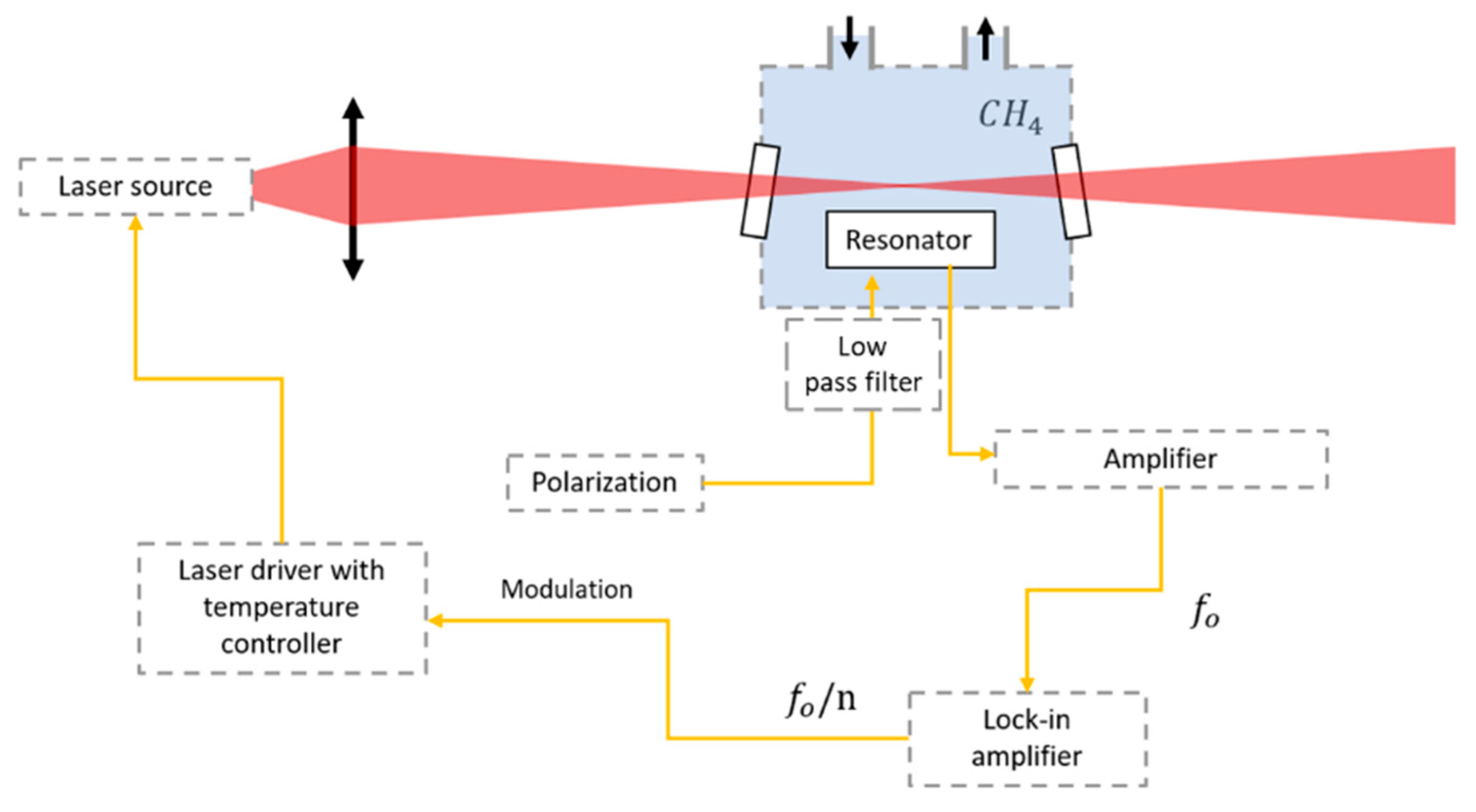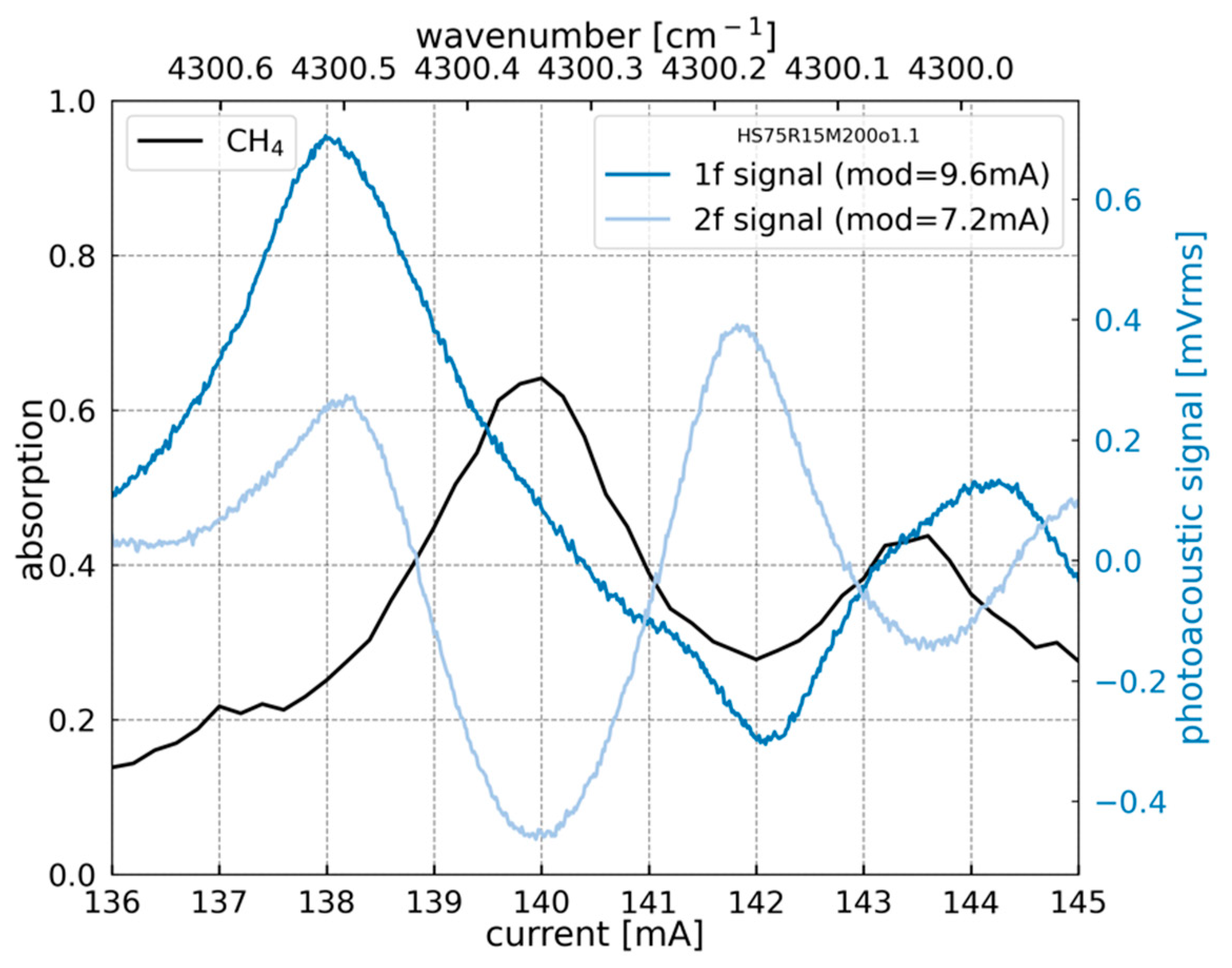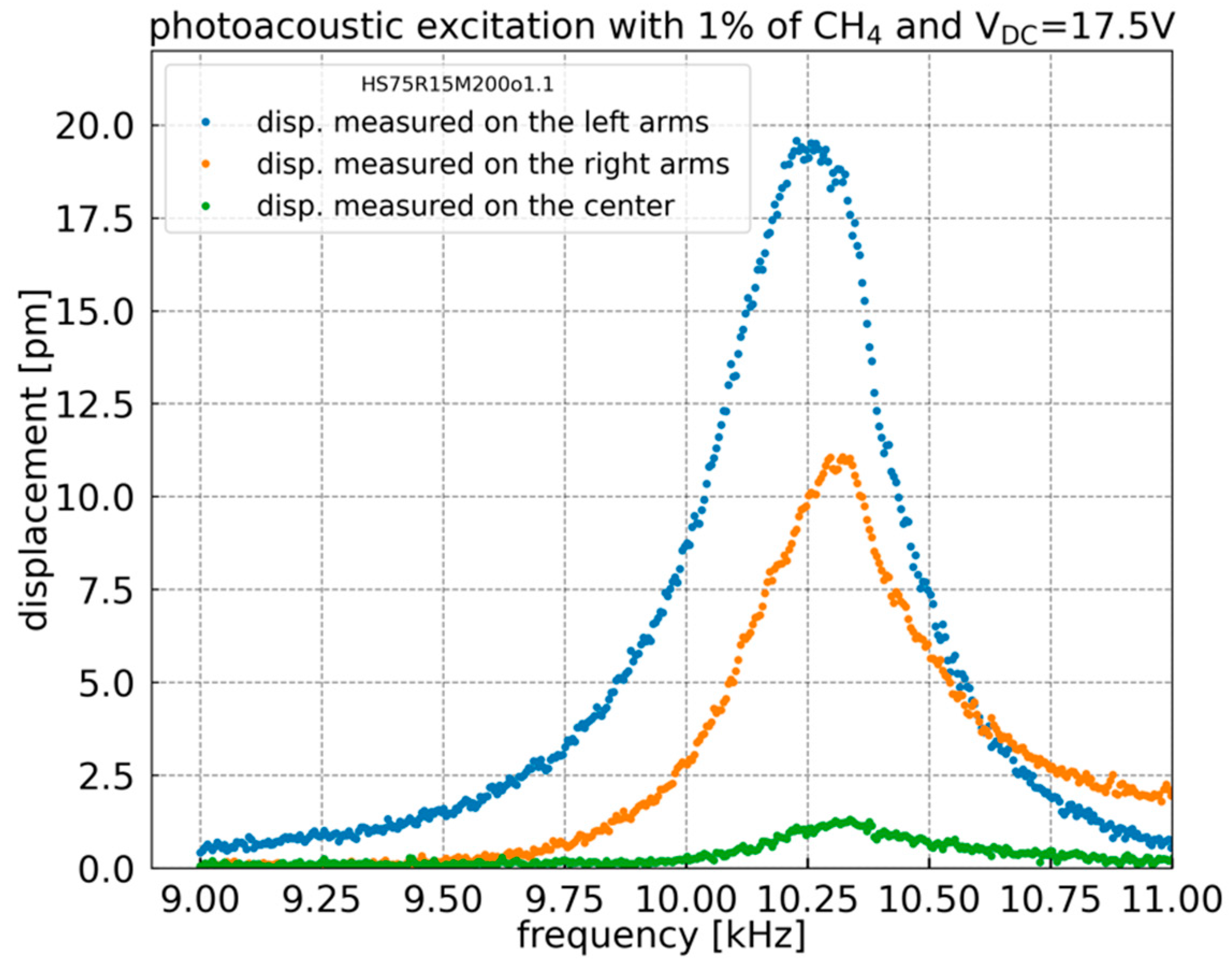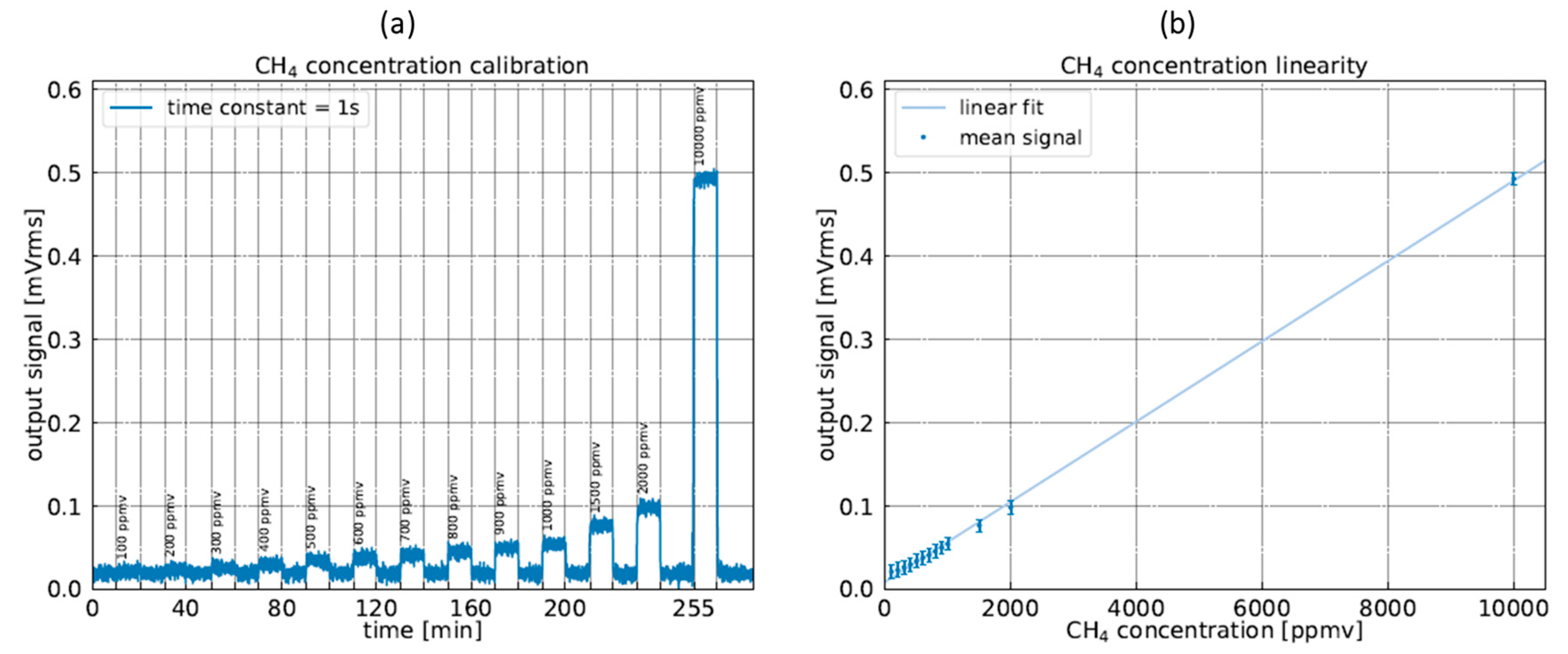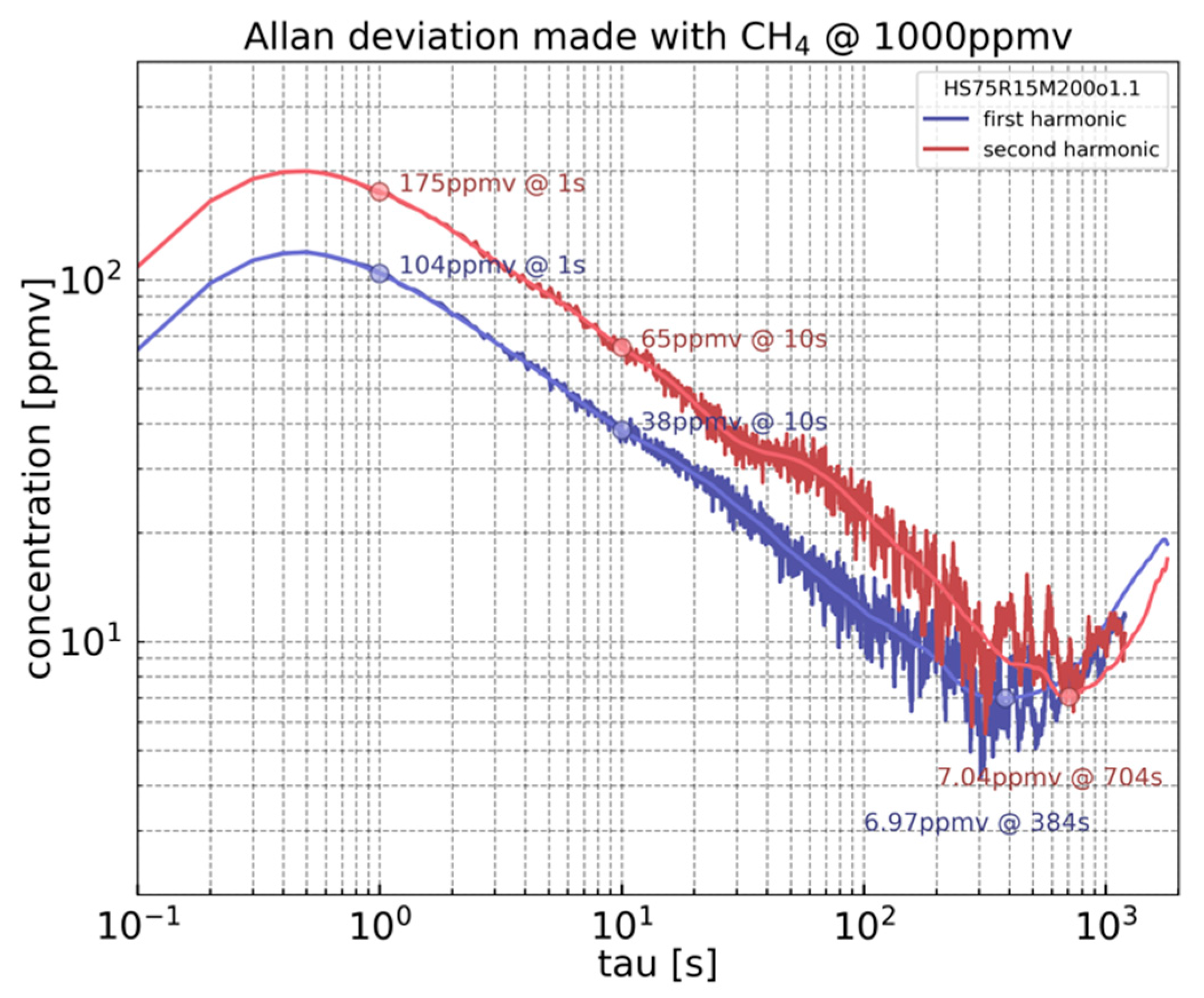1. Introduction
Gas sensors play a crucial role to control and monitor industrial and urban gas emissions. For applications related to human health like breath analysis or the detection of toxic/explosive gas such as methane, there is a need for a highly sensitive, selective, and compact gas sensor. The miniaturization of gas sensor is not only cost-effective, but also allows portability, which makes it suitable for most applications. Over the last decade, several gas sensors have been developed to detect and analyze a wide range of gases. The most commonly used gas sensors are electrochemical, semiconductor, and infrared (IR) sensors [
1]. Electrochemical and semiconductor sensors are characterized by their compactness and relatively low cost. Electrochemical sensors detect electron transfer events during electrochemical reactions, while semiconductor sensors operate by measuring changes in electrical resistance caused by the adsorption of target gas molecules. Both types of sensors are sensitive to the detection of gases such as methane, where the limit of detection can reach less than 9 ppmv and 5 ppmv for electrochemical and semiconductors sensors, respectively [
2,
3]. However, these sensors have decreased reliability and limited lifetime due to the impact of humidity and temperature, as well as the gradual consumption associated with chemical reactions. In addition, cross-sensitivity can occur for some gases, making these gas sensors less selective.
Among the various detection techniques, tunable laser diode spectrometry (TDLS) offers excellent properties in terms of selectivity, reliability, and sensitivity. It is also capable of reaching ppb levels, as illustrated in [
4], for methane detection. This technique includes a semiconductor modulated infrared laser whose wavelength corresponds to the absorption line of the target gas. This technique ensures a high selectivity due to the fact that the laser line is much thinner than the gas absorption line. The detection consists in measuring the intensity of the laser light passing through the gas cell using a photodiode. According to the Beer–Lambert law, the sensitivity of the IR absorption technique is proportional to the length of the absorption path, meaning that the performance relies on the size of the sensor. Therefore, the lack of compactness represents the main drawback of such a technique. This issue can be overcome by using photoacoustic spectroscopy which, compared to TDLS, differs in the way the light absorption is measured. After the absorption of the laser light by the targeted gas, the excited gas molecules will return into their fundamental level of energy after a non-radiative transition. This will increase the kinetic energy of the molecules and generate a periodic heating of the medium at the same frequency of the laser modulation, giving rise to acoustic waves having the same period. Hence, rather than using photodetectors, the measurement is performed using an acoustic sensor. In this case, the sensitivity is not proportional to the optical path, but to the power of the laser, which allows the development of compact gas sensors working with a small gas volume.
Each photoacoustic technique is defined by its acoustic sensor. The most used are
MPAS (Microphone based Photoacoustic Spectroscopy), which uses microphones with capacitive transduction;
CEPAS (Cantilever-Enhanced Photoacoustic Spectroscopy), which uses cantilevers with optical transduction;
QEPAS (Quartz-Enhanced Photoacoustic Spectroscopy), which uses quartz tuning forks (QTF) with piezoelectric transduction.
In MPAS, the main drawback is the interference of the ambient background with measurements [
5]. As for CEPAS, although it is efficient in terms of sensitivity, the issue lies in its sizable optical readout mechanism and in the need for an acoustic cavity [
6]. Regarding the bare QEPAS, it suffers from poor spatial overlapping between the acoustic wave and the prongs of the tuning fork, which induces a reduction in the signal-to-noise ratio (SNR) [
7].
These different drawbacks can be explained by the fact that none of these acoustic sensors are fully designed for photoacoustic spectroscopy. In this context, an innovative approach of developing silicon-based sensor, compact and integrated like a microphone and clearly resonant like a QTF, is adopted. We initially proposed this technique, called MEMPAS (MEMS-Enhanced Photoacoustic Spectroscopy) in 2019 [
8]. It consists of using a capacitive silicon micro-mechanical resonator, fabricated on a silicon-on-insulator (SOI) wafer. The use of silicon has the advantages of mature CMOS technology, notably precise dimension control, integration, and cost reduction for batch production. In addition, capacitive sensing is an attractive option which offers construction simplicity; highly doped silicon can be used as a capacitive electrode instead of having to perform metal deposition. An ideal capacitor has no intrinsic noise and is thus suitable for low noise sensing [
9]. These features allow for a sensor structure specifically designed for photoacoustic gas sensing. Evidence shows that it offers a high quality factor compared to microphones [
8].
However, the performance achieved by the first prototype we developed was far from the state of the art [
8]. This can be explained by the capacitive transduction mechanism, based on gap reduction, which generates an important viscous squeeze film effect due to the proximity between the two electrodes as described in [
10]. This effect reduces the mechanical resonator displacement; thus, the capacitance variations is limited and, therefore, its sensitivity. To minimize this effect, the resonator surface should be decreased. However, this reduces the collection of photoacoustic energy, which means that capacitive transduction exhibits opposite physical trends. This occurs because the same part fulfills two functions: photoacoustic energy collection and capacitive transduction. To overcome this problem, we have proposed an innovative design, named H-resonator [
11], which allocates these two functions to two distinct parts. Although the H-resonator exhibits performances close to the bare QEPAS technique, achieving superior sensitivity appears feasible by improving the photoacoustic energy collection, the displacement of the movable electrodes, and the nominal capacitance. In this regard, this study focuses on improving the H-resonator. The goal is to develop highly sensitive capacitive MEMS for photoacoustic gas trace detection. In this work, an electrical characterization is performed to determine the resonator frequency response and nominal capacitance. Then, under photoacoustic excitation, without using an acoustic cavity, the linearity of the sensor is examined under calibrated concentrations of the target gas. Finally, the performances of the developed sensor are evaluated in terms of its limit of detection (LOD) and its Normalized Noise Equivalent Absorption (NNEA).
2. Silicon Micro-Mechanical Resonator Design
The mechanical resonator is fabricated on a double-side polish (100) oriented SOI wafer. This latter is composed of 3 main layers: a 75-µm thick silicon device layer which corresponds to the resonator thickness, a 3 µm-thick box layer composed of silicon oxide, and a 400 µm-thick silicon substrate layer. The device and substrate layers are made of highly boron doped silicon with a resistivity of 0.01~0.02 Ω·cm to avoid any metal deposition and ensure capacitive transduction.
Figure 1 illustrates the proposed mechanical resonator, which will be referred to as the H-square resonator. It is an evolution of the previous design, the H-resonator [
11]. It is based on the same working principle that is presented in
Figure 1. The acoustic wave is created along the beam due to the absorption of modulated light. This absorption will occur if the laser wavelength corresponds to the absorption line of a target gas (methane in our study).
As shown in
Figure 1, the modulated laser beam is focalized above the center of the resonator so that once the central part moves downward by the action of the acoustic wave, the H-square suspended arms are deflected upward and vice versa. Consequently, the gap reduction between H-square suspended arms (movable electrode) and the substrate (fixed electrode) induces the capacitive signal.
The design approach consists in partitioning the resonator functions into a central zone dedicated to photoacoustic energy collection and side zone dedicated to capacitive transduction. Hence, these two functions can be separately optimized.
To enhance the collection of the photoacoustic energy, the structure size should be selected to resonate at a frequency which corresponds to the maximum acoustic pressure generated by the target gas. This maximum pressure is related to the target gas vibrational–transitional relaxation rate by means of the heat production rate, expressed in [
10]. The wide central part is devised to overlap with the acoustic wave and thus increase the applied force, as the wider the surface, the higher the force will be. A hole is etched under the central part to avoid the squeeze film effect. A gap of 50 µm is ensured between the hole edges and the resonator central part. Knowing that the acoustic wavelength at the resonance
λa∼3.4 cm (
λa =
, where
is the speed of sound = 343 m/s and
is the frequency = 10 kHz), this reduced gap together with the resonator thickness (~75 µm) allows the pressure difference between the upper and back sides of the mechanical resonator to increase. Thus, the applied force is increased, as illustrated in [
10].
To enhance the resonator displacement, the mechanical susceptibility and the structure quality factor should be maximized. For that, the central back etched hole and the thin separated arms of 12 µm width contribute to prevention of viscous damping. It is important to note that the target resonant mode must be the one where the arms of both sides of the H-square resonator move vertically in-phase (in the same direction). This mode allows to ensure the most efficient conversion of mechanical movement into capacitive signal. In addition, the supports, which holds the structure, are placed at the nodes of the target resonant mode to avoid motion restraints. All these features ensure a high displacement ratio between the extremities of the arms and the central part of the resonator. Consequently, the mechanical energy dissipation and the effective mass, which represents the mass part of the structure involved into motion, are reduced. This increases the mechanical susceptibility and thus, the structure sensitivity, to enhance the signal-to-noise ratio (SNR) [
10].
Regarding the structure side parts devoted to capacitive transduction, perpendicular arms together with horizontal ones are employed to simultaneously increase the nominal capacitance, the structure stiffness, and the separation between resonant modes [
11]. However, this increases the effective mass, thus, minimizing the displacement of the arms and consequently inducing a reduced capacitive signal. To provide a good compromise, the structure mass is lightened by limiting the number of arms.
In order to predict the design performance, parametric studies were first conducted using the finite element modelling COMSOL software together with an analytical model, presented in [
10]. Combining numerical and analytical simulations allows us to determine the optimal design of the MEMS by estimating, for each design, a theoretical detection limit for methane.
Figure 2a depicts a simulation that illustrates the movement of the MEMS at its resonance frequency. The arms of the resonator exhibit a greater displacement than its central part, which enables the reduction of effective mass while maintaining a large surface area for collecting acoustic forces. This configuration allows for optimal performance and sensitivity of the MEMS device. Once the numerical/analytical prediction fulfills previously mentioned and required improvements, the mechanical resonator is fabricated using the same process as the H-resonator, detailed in [
11].
For the measurements, the substrate is polarized with a DC bias voltage
.
Figure 2b presents the fabricated H-square resonator, with its aluminum wire bonding to measure the output capacitive current.
3. Electrical Characterization
The electrical characterization aims to determine the H-square frequency response, quality factor, and nominal capacitance.
Figure 3 illustrates the electrical characterization circuit, with an equivalent linear small-signal circuit used to describe the mechanical resonator. A DC polarization voltage (
) and an AC drive voltage (
) are applied to one electrode of the mechanical resonator. A transimpedance amplifier (TA) then keeps the second electrode at the electrical ground.
According to Butterworth–Van Dyke model [
12], the H-square resonator can be modeled as a series
RLC circuit with a parallel capacitance
. An electrical
RLC and a mechanical Mass-Spring-Damper (MSD) system have same form of differential equations. If we consider by analogy that the voltage represents the force,
R is proportional to the damping, representing the system losses,
L is proportional to the effective mass, and
C is inversely proportional to the stiffness.
accounts for fixed electrical feedthrough capacitance and can be expressed as follows:
is the capacitance caused by the 3 µm air gap between the suspended H-square arms and the substrate. As presented in
Figure 1, the arms are the movable part of the H-square that generate the output electrical signal. By opposition,
represents the parasitic capacitance induced by all the other parts of the H-square that contributes to
. The silicon square supports holding the structure and separated from the substrate by a layer of 3 µm silicon oxide layer mostly participate in
. The output current, generated by the displacement of the H-square arms, is amplified and converted into voltage using a transimpedance amplifier (TA) with 10
8 gain, followed by a lock-in amplifier.
In such a damping circuit, the H-square admittance
(Ω
−1) varies as follows:
where
and
are the H-square equivalent linear small-signal circuit impedance (Ω) and
TA gain (V/A), respectively.
The frequency response of the H-square resonator is analyzed under different
bias voltages, as shown in
Figure 4. The frequency profile is composed of a first main resonance peak followed by an anti-resonance/opposite peak due to the feedthrough capacitance
. In addition, the effect of
appears far from the resonance where the H-square resonator is immobile, and thus, where
. This leads to an output current
and an output voltage
which can be expressed as follows:
where
is the drive potential
frequency.
This simply allows
to be deduced:
All the experimental data are fitted using the Butterworth–Von Dyke model, thus allowing to estimate the resonance frequency
, quality factor Q, and feedthrough capacitance
. Based on the dimension of the H-square design, the theoretical
C0 and
Cp are equal to 5.66 and 3.11 pF, respectively. Compared to the measured
(=5.51 pF), the relative error is about 3%. As illustrated in Equation (2), to improve the sensitivity of the developed sensor,
must be maximized without increasing
. The output signal attenuation can be evaluated according to this ratio:
[
5]. Here, the resulting attenuation factor is 0.65, higher than that of the previous H-resonator (0.18) [
11].
Figure 4 clearly shows a resonance frequency shift with the polarization voltage. This shift is caused by the DC force generated by the polarization. Moreover, the signal increases with the polarization voltage. However, it is important to know that beyond a certain limit, a further increase of the bias voltage may lead to non-linearities and the collapse of the resonator, as observed in [
13]. The capacitive signal generated by the deflection of H-square resonator is maximum with a polarization voltage of 17.5 V, inducing a resonance frequency of ~10.3 kHz and Q of ~22. This exact same polarization voltage will be further applied for the following measurements of this study.
5. Discussion and Perspectives
The work presented in this paper was motivated by the need for a highly sensitive, selective, and compact gas sensor. To meet this objective, a new photoacoustic technique, dubbed MEMPAS, is developed. This method consists of using a resonant capacitive MEMS specifically designed for photoacoustic gas sensing with higher quality factor compared to microphones. The proposed H-square resonator represents an improved generation of an early stage developed resonator characterized by its ability to limit viscous damping. It is composed of a wide central part dedicated to the collection of photoacoustic energy and side-parts of thin arms dedicated to the capacitive transduction. Unlike the QTF, the design maximizes the overlap of the acoustic wave through the surface of the central part while maintaining a reduced effective mass. This is ensured thanks to the high displacement ratio between the side-parts and the central part of the H-square resonator.
In this work, the photoacoustic energy collection is improved by increasing the pressure difference between the upper and back sides of the mechanical resonator. This is performed by setting a reduced gap of 50 µm between the resonator central part and the edges of the hole, which have been etched underneath. Additionally, the resonator length is chosen to operate at a frequency which corresponds to an acoustic pressure close to the maximum of pressure generated due to the absorption of the laser light by the target gas. Furthermore, to reduce the support dissipation, the supports holding the structure are placed at the nodes. Regarding the improvements for the capacitive transduction, perpendicular and horizontal thin separated arms were employed to simultaneously increase the nominal capacitance, the structure stiffness, and the separation between resonant modes.
In this article, we have demonstrated the operating principle of our gas sensor using methane. However, it is worth noting that this same sensor can be used to detect a wide range of gases, not just methane. This is due to the fact that our gas sensor is based on photoacoustic spectroscopy. By replacing the laser used in the sensor, it can detect any gas, making it highly versatile and adaptable to various applications.
The electrical characterization confirms that the H-square resonator operates at a frequency of 10.28 kHz, which corresponds to acoustic pressure close to the maximum of pressure generated due to the absorption of the laser light by the target gas. It also reveals that the nominal capacitance and output signal attenuation are increased in comparison with the previous H-resonator [
11]. The photoacoustic experiment demonstrates the viability of the H-square resonator for methane trace detection. The linear response of the resonator is validated on calibrated methane concentrations.
Concerning the quality factor, the H-square exhibits a quality factor of ~22, which is low compared to the QTF quality factor, estimated to be ~10,000. It is important to note that under vacuum, piezoelectric excitation of the H-square leads to a quality factor of 1570. This reflects the significant effect of the viscous damping on the total quality factor of the H-square due to its low resonance frequency. Further design optimizations are needed to achieve higher quality factor, mainly by improving the viscous and the support quality factor [
10].
In terms of sensitivity, the H-square resonator performances are superior by a factor of 6.4 compared to the previous H-resonator and by a factor of 1.5 compared to the bare QEPAS, a state-of-the-art reference to compact and selective gas sensors. Hence, by optimizing the MEMS design and maximizing its sensitivity, the objective of this research is to obtain the best possible sensor performance. With this accomplishment, the next step would be to integrate an acoustic cavity to further enhance the sensor sensitivity and signal-to-noise ratio (SNR). For instance, in QEPAS, the acoustic cavity allows to yield a factor of 30 [
17,
18,
19]. In our case, the gain is expected to be even higher than in Cantilever-Enhanced Photoacoustic Spectroscopy (CEPAS), where the coupling between the acoustic cavity and the cantilever is optimized. The possibility of achieving such perspective allows obtaining a highly performant gas sensor among photoacoustic techniques while remaining compact.

